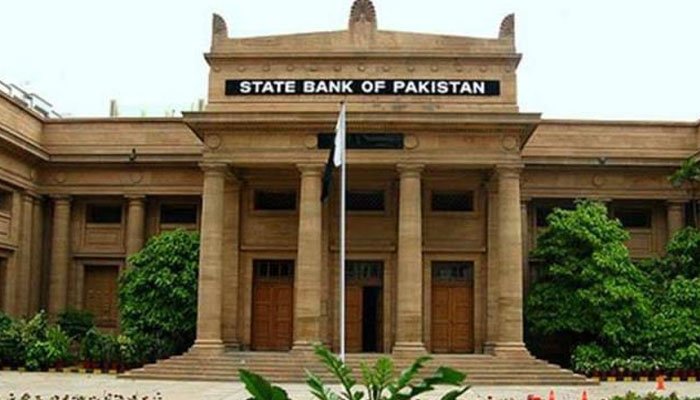Inflation touches highest level in seven years: State Bank of Pakistan
Pakistan’s economic growth is unlikely to meet the target of 4 percent this fiscal, due to soft trends in agriculture and manufacturing production, the central bank said
KARACHI: The State Bank of Pakistan (SBP) on Monday said during the first quarter of current fiscal year FY-20, Pakistan's economy moved progressively along the adjustment path, but inflation reached the highest level during the last seven years.
Pakistan’s economic growth is unlikely to meet the target of 4 percent this fiscal, due to soft trends in agriculture and manufacturing production, the central bank said, advising the government to address structural vulnerabilities to put the economy on a sustainable growth trajectory.
Performance of commodity producing sectors would likely remain subdued, the SBP said in its report. “In view of these developments, achieving the real GDP growth target of 4 percent appears unlikely,” the SBP said. The central bank’s report spells out in sharp detail the challenges being faced by the economy including mismatch related to exports quantum and earnings, delays in implementation of tax measures and weak management in food prices.
“Most of the improvement in the current account has come from a reduction in the country’s import bill; exports have yet to contribute significantly, as healthy quantum gains are not supported by price trends,” the SBP said.
Furthermore, while the drawdown in foreign exchange reserves has been reversed, the overall reserves position remains below the comfort level (in terms of import coverage).
The report further highlighted that the average headline CPI inflation reached 11.5 percent in Q1-FY-20, extending the steep upward trend persistent since the beginning of FY-19. Not only this level was double the inflation observed in the same quarter last year, it was also the highest level of quarterly inflation since Q4-FY-12. Macroeconomic stabilisation process picked up momentum with the initiation of the IMF’s Extended Fund Facility programme: the SBP continued to keep the monetary policy consistent with the medium-term inflation target; whereas, consolidation efforts were visible on the fiscal front.
The current account deficit in Q1-FY20 fell to less than half of last year's level, primarily on the back of significant import compression. Owing to low unit prices, exports growth remained low.
On the external front, the balance of payments continued to improve during Q1-FY-20. Beside significant improvement in trade deficit, and with the receipt of the first EFF tranche from the IMF and increase in foreign portfolio investment, the current account gap was plugged by the available financial flows.
These inflows also helped the SBP to increase its foreign exchange reserves by $656.2 million and reduce its net forward liabilities by $1.3 billion during the quarter.
-
 Japan Unveils Anti-ship Missile With ‘barrel-roll’ Evasion To Outsmart Defenses
Japan Unveils Anti-ship Missile With ‘barrel-roll’ Evasion To Outsmart Defenses -
 How Brooklyn Beckham 'mentor' Prince Harry Inspiring Him To Speak Against Family?
How Brooklyn Beckham 'mentor' Prince Harry Inspiring Him To Speak Against Family? -
 Zac Efron, Kenny Ortega Revisit 'High School Musical' After 2 Decades
Zac Efron, Kenny Ortega Revisit 'High School Musical' After 2 Decades -
 Threads Overtakes X On Mobile Users: Here’s Why Everyone’s Switching
Threads Overtakes X On Mobile Users: Here’s Why Everyone’s Switching -
 Kanye West Eyes Performing First-ever Concert In India
Kanye West Eyes Performing First-ever Concert In India -
 Brooklyn Beckham's Claim About Nicola's Wedding Ordeal Gets Challenged
Brooklyn Beckham's Claim About Nicola's Wedding Ordeal Gets Challenged -
 AI Horror: 4 In 5 Young Workers Fear 'AI Could Replace Their Jobs', Says Report
AI Horror: 4 In 5 Young Workers Fear 'AI Could Replace Their Jobs', Says Report -
 Missouri Couple ‘locked Sons In Chicken Pen, Shot Them’ In Shocking Abuse Case
Missouri Couple ‘locked Sons In Chicken Pen, Shot Them’ In Shocking Abuse Case -
 King Charles Receives 'delightful' Royal Baby News
King Charles Receives 'delightful' Royal Baby News -
 Chinese ‘mega Embassy’ Wins UK Approval In London Ahead Of Starmer’s China Visit
Chinese ‘mega Embassy’ Wins UK Approval In London Ahead Of Starmer’s China Visit -
 David Beckham Gives Telling Reaction To Brooklyn’s Public Complaints
David Beckham Gives Telling Reaction To Brooklyn’s Public Complaints -
 Can Ibuprofen Cut Cancer Risks? Study Finds Promising Breakthrough
Can Ibuprofen Cut Cancer Risks? Study Finds Promising Breakthrough -
 Piers Morgan Finally Reacts To Brooklyn Beckham's Statement About David And Victoria Beckham
Piers Morgan Finally Reacts To Brooklyn Beckham's Statement About David And Victoria Beckham -
 Tom Hiddleston Reveals Unlikely DC Character That Inspired Loki
Tom Hiddleston Reveals Unlikely DC Character That Inspired Loki -
 Prince Harry, Meghan Markle Warned 2026 Will Be 'a Big Test' For Them
Prince Harry, Meghan Markle Warned 2026 Will Be 'a Big Test' For Them -
 OpenAI Plans First ChatGPT Device For 2026
OpenAI Plans First ChatGPT Device For 2026




